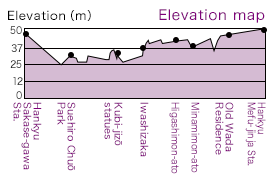Explore on foot
Hankyu Sakasegawa Station — Kohamajuku
— Hankyu Mefu-jinja Station[4.8 km]
Kohama is an area rich in history. It thrived as a semi-fortified town built around Gōshōji Temple at the end of the 15th century (Sengoku Period). During the Edo Period, the post-station town of Kohamajuku flourished at the convergence of three routes: Kyō-fushimi-kaidō, Nishinomiya-kaidō, and Arima-kaidō. Renowned for the quality of its Tamanoi spring water, the area was home to many sake breweries. The carpenters of the town also drew widespread acclaim.
This route gives you a look into Kohamajuku’s rich history. You can start the course from Hankyu Sakasegawa Station or from other Hankyu stations such as Kiyoshikōjin, Mefu-jinja, or Yamamoto. Depending on your schedule and fitness level, you can choose to visit just the Kohamajuku area or you can plan a day trip that includes Kiyoshikōjin Seichōji Temple or Nakayamadera Temple.
 Note: Sections of the route pass through residential areas. Please walk through quietly with consideration for local residents.
Note: Sections of the route pass through residential areas. Please walk through quietly with consideration for local residents.
Note: Another way to get to Kohamajuku is by taking a Hanshin Bus from Takarazuka Station (Hankyu or JR) and getting off at Kohama bus stop.

Ōhorigawa River flows around Kohamajuku. Along the banks of the river is a path from which you can enjoy viewing cherry blossoms or autumn foliage. The Iwashizaka slope at the end of this path is said to have been used for unloading iwashi (sardines) off boats in ancient times, when Kohama was a beach on the Seto Inland Sea.
After going up Iwashizaka, you’ll see Kitamon-ato Atagogū Shrine. This was once the location of the kitamon (north gate), one of three gates built to guard the town. Inside, a statue of Atago (the deity of protection from fire) stands ready to defend the town from flames.
In the very center of Kohamajuku you’ll find this free-to-enter museum. It’s built on the premises of the old Yamanaka residence, home of the famous Tamanoi spring water. Historical documents related to Kohamajuku and everyday tools are collected here. Learn the history of Kohama through videos and dioramas of Edo Period Kohamajuku.
During the Sengoku (“warring states”) Period, Kohama was a semi-fortified town centered around Gōshōji Temple and surrounded on three sides by Ōhorigawa River. There were defensive gates at each of the exits to the three kaidō routes. This was the location of the higashimon (east gate), which connected to Kyō-fushimi-kaidō.
Kohama was known for its skilled carpenters, many of whom helped to rebuild the Hamaguri-gomon gate at the Kyoto Imperial Palace. The carpenters must have passed through this exact gate on their way to that important task.
A monk named Zenshū founded the village of Kohama and built Gōshōji for the Jōdo Shinshu sect. The village developed as a semi-fortified town centered on the temple. By one account, warlord Toyotomi Hideyoshi took part in a tea ceremony here with tea master Sen no Rikyū, following a therapeutic visit to Arima Onsen hot springs. The warlord’s nephew Toyotomi Hidetsugu is said to have taken a daughter of the temple as his concubine.
The minamimon (south gate) was the southern entrance to Nishinomiya-kaidō, a route that went from Nishinomiya to Kohama via Obayashi and across the Mukogawa River. It was also called Umakaidō (the horse road).
Heading north on Nishinomiya-kaidō from the former south gate, you’ll see Kohama Kōtai-jinja to your left. This shrine was built in 1441. Dedicated to the deity Amaterasu-sumeōkami, it guards the town of Kohama. Annual festivals held here include the Danjiri-matsuri in October and the Kohama Ebisu-matsuri in January.